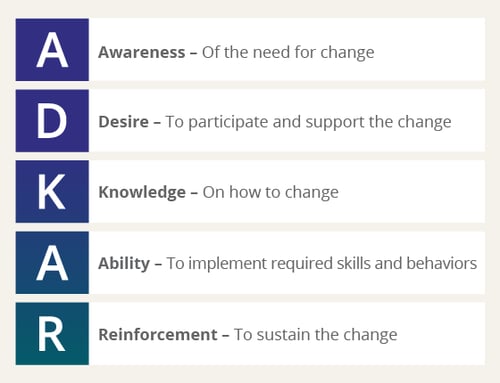Prosci's Top 10 Tactics for Managing Resistance to Change

5 Mins
Updated: November 14, 2025
Published: June 8, 2022

Resistance management is a critical activity for people managers during change. Of the five CLARC roles managers perform—Communicator, Liaison, Advocate, Resistance Manager and Coach—it's often the most difficult to learn and execute well. Applying Prosci's Top 10 Tactics for Managing Resistance will help you identify and focus on the right issues—so you can help your teams through their change journeys, and engage with and adopt critical changes in your organization.
|
Prosci's Top 10 Tactics for Managing Resistance
|
Prosci's Tactics for
Managing Resistance to Change
A large part of being a strong resistance manager is being proactive or preventative. Resistance prevention, or anticipating and planning to deal with resistant behaviors, is built into the entire Prosci 3-Phase Process. It's also the primary focus of our six-hour program for people managers, Leading Your Team Through Change. However, when resistant behaviors persist, you can use the tactics Prosci developed to help impacted people on your team move through their transitions.
Note that resistance management is not about assigning blame to people or labeling them as "resisters." Resistant behaviors are a natural reaction to change. Applying these tactics enables you to meet people where they are with empathy and address the underlying reasons for why they're not adopting changes. The tactics are also designed to be applied in the order presented.
1. Listen and understand objections
When experiencing resistant behaviors, the first and most important thing to do is listen to understand the reasons for the objections. While this sounds like common sense when juxtaposed against the fast-paced corporate world, even the most seasoned manager can forget to listen. Too often, managers and teams bypass each other in conversation because they're not actively listening and understanding one another. In Prosci programs, we often discuss the sender-and-receiver concept because people listen through their personal filters.

2. Focus on the "what" and let go of the "how"
"Don't do the change to me—do the change with me!" As the people manager, we should focus on what needs to be accomplished and offer the team the opportunity to provide input on how to accomplish the change. When you know the end goal, the approach for getting there can be shared by those proceeding through the change. We see this when organizations move to a hybrid work environment. Organizations that transition quickly are encouraging people to share input on how to proceed forward.
3. Remove barriers
As a people manager, you understand where your team members' resistance points reside. Perhaps they are related to job motivation, job security, career progression and personal commitments.
Consider, for example, an organization that just switched out everyone's laptops. A team member now finds doing their work uncomfortable, so they don't want to finish it. That's a physical barrier. And employees may not feel like they should have to tell you that. When people managers come up against this kind of resistant behavior, they can probe to understand and help employees address what's holding them back from adopting the change.
4. Provide simple, clear choices and consequences
In some cases, a people manager must be direct by saying, "I understand that you may not be interested in participating in this change, but the team will follow this new process as explained by our Awareness campaign. If you don't choose to adopt the new changes, X will be the result." The key is to provide choices in a clear and straightforward manner, and include any consequences of their decisions.
5. Create hope
Creating hope focuses on the future state. What's on the other side of adopting and using the change? What is the opportunity associated with it? Having a well-constructed "why" helps with creating hope.
Think through this template: "If we just do X, we will be able to do Y."
For example, "By completing this digital transformation initiative, we will achieve greater collaboration to serve our clients and reduce the time spent on administrative tasks." People managers can create Desire for the change by sharing their authentic passion through creating excitement and enthusiasm.
6. Show the benefits in a real and tangible way
People can have a hard time envisioning the future state of a change. We like to say that the current state is rooted in emotion, but the future state is rooted in analytics. In other words, when a person has never done something before, you can show them through data and evidence that they're going to get there.
For example, consider sharing case studies or information explaining how others have navigated the change and how things have been better because of it. This tactic is an excellent way for a people manager to cool down resistant behaviors.

7. Make a personal appeal
Try making a personal appeal to teams with a high degree of trust and an open relationship. Ask for your team's support and restate why you believe the change will benefit the team. To authentically advocate for the change, ensure that you have worked through your own Awareness and Desire before starting the team's ADKAR journey.
8. Convert the strongest dissenters
The most vigorous dissenters can become your strongest advocates. Sometimes the natural tendency is to avoid the strongest dissenters. However, if the manager can invest in interventions or tactics to convert dissenters, they might find a strong advocate. Focus on Awareness and Desire, and articulating what's in it for them (WIIFM). Listen for the root cause of their resistant behaviors and solve it from there.
For example, if you're taking away job responsibilities or changing the compensation structure, those are challenging changes. What's in it for someone on the receiving end? Converting the strongest dissenters is all about the art of an Awareness-and-Desire conversation. Remember that everyone goes through their ADKAR journey at their own pace. As the people manager, you may need to have the conversation a few times. Use your ability to anticipate the resistant behaviors and help plan for the strongest dissenters. What can you have prepared to help them move forward?
9. Demonstrate consequences
As a last resort, demonstrating consequences is a viable form of resistance management. However, use this tactic with caution. Once employed, the results will become part of the organizational history that may have cascading impacts on employee engagement. Consult with HR and legal before using.
10. Provide incentives
In this tactic, people managers can offer bonuses, extra time off, or the ability to work from home in exchange for adopting the change—a little quid pro quo. Sometimes it's effective and sometimes it's not.
I've seen this work well during an artificial intelligence transformation initiative. The company offered a group of exiting employees a retention bonus to provide training and coaching to the process enhancement team. The exiting employees took the offer and worked tirelessly to make the transformation a success, even though the result would be that they would no longer have a job. When asked why they were so helpful, they shared that although they appreciated the bonus, their pride in their job and gratitude to the company got them through the change. In addition, they wanted to end their time there with dignity and respect.
Resistance Management Tactics in Practice
In reality, people managers will use several tactics to help resolve a single issue. Good managers always start with listening to objections and proceed from there. For example, when converting strong dissenters, you might start by listening to objections, explaining why we're making the change, creating hope, showing some benefits, and maybe providing clear choices. Finally, you might need to go back to make a personal appeal, remove barriers, and listen and understand objections.
You may also have a great conversation and think the issue is resolved, only to have the conversation again. People don't all change at the same rate—some need more time to move between their current, transition and future states. And that's OK. To help expedite your conversations, anticipate the resistant behaviors and respond proactively. As you develop skills as a people manager, the tactics feel familiar and natural in certain situations, and you'll get better at it over time. That's the beauty of Prosci's resistance management tactics.
Learn to Manage Resistance to Change
Resistance is a normal, human reaction to change. And as such, you should never underestimate the comfort with how things are currently done. As a people manager, you may want to ignore the resistance, hoping it will dissipate or believing the issue to be on the team member's side. However, resistance can always be linked to a missing ADKAR element. So, before casually labelling a team member as a "resister," try employing these top 10 tactics to address the behaviors.






